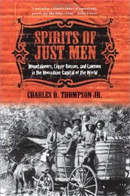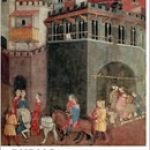Spirits of Just Men: Mountaineers, Liquor Bosses, and Lawmen in the Moonshine Capital of the World

Author: Charles D. Thompson, Jr.
Champaign, IL: University of Illinois Press, 2011. 269p.
Reviewer: Mercer L. Sullivan | November 2011
This historical study of illegal liquor production in the Appalachians provides a fascinating account of a storied form of illegal enterprise that challenges stereotypes of a marginalized population while bringing a much-needed political economic perspective to the study of crime. In order to account for how Franklin County, Virginia, gained a national reputation during the first half of the 20th Century as "the moonshine capital of the world," the author combines personal reminiscences about his own family with analyses of primary documents from the period and cogent summaries of immigration history and national trends in agricultural development, alcohol regulation, and law enforcement. Though it focuses on moonshining, the book’s larger purpose and considerable achievement is that of portraying a regional culture from the earliest days of its development through its virtual extinction by mid-century as World War II drew the last hold-outs of mountain agriculture into the modern economy and much of the area formerly populated by hardscrabble farmers reverted to leafy woodlands surrounding the scenic Blue Ridge Parkway.
The author begins and ends in overtly personal terms, recounting how he discovered only as adult that his beloved grandfather had been peripherally involved in the moonshine business when he was younger, as a driver for the area’s principal export. Though he toiled all his life on the family farm, he was never able to make ends meet without outside employment such as delivering newspapers well into middle age. Hard as his grandfather worked and as upstanding a citizen in most ways as one could imagine, he was one of the few who managed to hold onto a family farm over the years, as modern agribusiness drove down prices and made the way of life of mountain farmers increasingly untenable. His grandfather held on not just because he worked hard but because he had one of the better pieces of land. He had been able to acquire that land as a young man by risking his life transporting illegal whiskey. On discovering this, the author began to study his area as a serious historian, gradually uncovering the central role of moonshining in that local area over a period of decades.
Though a few local businessmen, corrupt politicians and law enforcement officers raked off most of the considerable profits, the moonshine business was pervasive throughout the area, touching most families directly or indirectly. Most of these families were and remained poverty-stricken. For the vast majority, their ties to moonshine production were only a sideline to the unremitting backbreaking toil of working farms that supplied most of their food but little in the way of cash crops, increasingly little as time went by. They risked their lives and prison terms for the barest minimum of cash to purchase goods in the market economy. For their trouble, they gained a reputation in the nation’s capital as ripe targets for successive Federally initiated law enforcement campaigns to stamp out their illegal activity, first during Prohibition and then subsequently as tax evaders threatening the corporate consolidation of the national liquor industry.
The author arranges much of this story around three criminal trials that drew national attention at the time and were the subject of extensive journalistic coverage. This included a series of magazine articles by the novelist Sherwood Anderson, who had gone to live in the Appalachians in the 1920’s. First came a conspiracy trial in 1935, followed by a jury tampering trial related to the original conspiracy the following year and then by a murder trial for the killing a law enforcement officer who had been suspected of being willing to testify against the ringleaders in the conspiracy trial. Despite many convictions, the man who appears to be have been the chief conspirator, county prosecutor Carter Lee, putative descendent of Robert E. Lee, was himself never convicted. He continued in office and died of natural causes in 1958.
These stories, while highly entertaining and informative, have been told before, by Sherwood Anderson and others. By themselves, they do not justify the present work. They function here as a template for telling a story much more complex than one of whodunit and who ended up taking the rap. This is the story of the history and culture of the region and the way that an isolated regional culture could become the fulcrum of a nation’s struggles with agricultural development and deeply divided attitudes about alcohol production and consumption.
It is the way these aspects of U.S. history emerge through close examination of one mountain county and primary documents from and about a selected handful of its residents that provides the considerable interest of this book for scholars interested in patterns of crime and justice.
After the opening familial reminiscences, the book starts rather ponderously with several repetitions of it’s major theme: that the "illegal spirits" at the center of the notorious trials were in fact produced by "just men" who worked hard, supported their families, cooperated in communal labor, received no government services, and desperately needed the small amount of cash available to them through illegal liquor production and practically no other avenue. The fact that this particular area, rather than many other areas sharing similar conditions, gained the reputation, apparently well-deserved, as the "moonshine capital of the world" appears to be due mostly to the organizing of their efforts into an export industry by a few scheming liquor bosses and lawmen who seized the opportunities presented first by Prohibition and then by taxation and corporatization of the liquor industry after Prohibition.
The book grows steadily more interesting as the author moves the story first back to the British Isles and the immigration of land-starved farmers from Scotland to Ireland to the Southern Appalachians and then forward from the late 19th to the mid-20th Century. Two themes are central to this cultural history: the search for land and ongoing cultural expertise in distilling spirits. At each step along the way, the people who came to be called Scots-Irish were squeezed out of their land and simultaneously persecuted for making whiskey and exploited by these same persecutors who wanted to drink it.
By the arrival of Prohibition, this process had already been going on for centuries. After they had settled in the Southern Appalachians, these people learned to substitute corn for wheat and barley and developed a preference for the taste of corn whiskey, which they made quite legally for their own consumption for decades. As thirsty urban Americans began to make and consume rotgut whisky and bathtub gin during Prohibition, the reputation of Appalachian corn whiskey soared. It was made in small batches by meticulous craftsmen who only survived on their poor mountainous landholdings by virtue of their highly developed and diverse craft skills. As the sale of small individual amounts to outsiders became consolidated into a much more organized enterprise controlled by local politicians and law enforcement, however, the quality began to decline. The community also frayed as what had once been a cottage industry became riven by paid or intimidated informants and lawmen protecting some while sacrificing others to keep the proponents of the Federally led crackdown happy.
One of the author’s most intriguing observations is that, from today’s vantage point, the traditional corn whiskey of the area was exactly the kind of artisanal production now so much in vogue among upper-middle-class consumers and patrons of urban farmers’ markets. During the New Deal, Federal agriculture officials paid lip service to promoting economic development in mountain areas, but of course the idea of encouraging them to make whiskey was out of the question in terms of the political discourse of the time.
Much of the story comes in descriptions of the trials and the participants. Two key individuals who receive separate chapters were both religious leaders who testified as character witnesses for one of the men convicted in the jury-tampering trial, Amos Rakes. Though they may have been sincerely skeptical that Rakes had any part in bribing the jurors who exonerated the District Attorney who was the ringleader of the entire enterprise, both these religious leaders knew quite well that Rakes had been producing moonshine for a long time. Nonetheless, he was in every other way a "just man" who supported his family and his neighbors and their own churches. They may have been ambivalent about the moonshine trade and preached regularly against drunkenness, but they resented the persecution of the "just men" in their community who were only struggling to survive.
These two religious leaders were very different from each other and, in some ways, rivals for the spiritual allegiance of the local people. One, Elder Goode, was a Primitive Baptist, a hard-pressed local farmer himself who received no pay for his arduous work preaching and ministering at four widely separated churches in different corners of the county. Primitive Baptists were highly conservative about many things, but, unlike many modern Baptists, not particularly disapproving of whiskey as long as not consumed in excess. The other leader was an Episcopalian missionary, Miss Ora Harrison, who came into the community from a nearby city separated from the mountains by only a few miles but also by a wide cultural gap. She was part of the Social Gospel movement of the time that sought to educate and modernize the backwards mountain people. She founded a mission and school that endured for decades and provided the main source of education for local children for many years. Though their community and church backgrounds were at odds in many ways – the locals suspicious of outsiders, the outsiders seeking to civilize the locals – the two leaders actually got along well personally and cooperated in many ventures, including flirting with perjury by testifying, unsuccessfully, on behalf of Amos Rakes.
Elder Goode was for many years prone to write down daily notes about all aspects of life on calendars that his family saved. Miss Ora was highly educated and wrote many letters. These two sources of primary documents provide much of the structure on which the rest of the story is built. Combining these with other sources, the author describes in detail such things as just how corn whiskey was made and how law enforcement agents went about trying either to stamp it out or, alternatively, make it look like they were.
The result of this synthesis of personal reminiscence, incisive summaries of secondary historical sources, and analyses of primary documents is a rare portrait of illegal enterprise and how it is situated in a particular historical, ecological, and cultural context. It would be facile to compare it directly with the illegal drug trade in today’s inner cities. There are too many differences. There are also many striking similarities.
Mercer L. Sullivan, Associate Professor, Rutgers School of Criminal Justice


